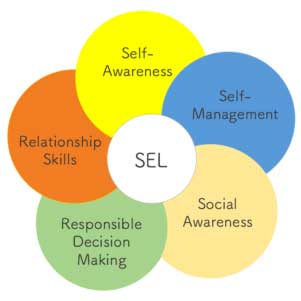December 2, 2021
For many years, the focus within classrooms has been centered on high-stakes assessments. How students were performing on state exams was supposed to tell the story of student achievement—or, at least, most of the story.
However, the number of research studies has increased on this topic and the evidence for why social-emotional learning is important—indeed, essential—for student success is overwhelming. Let’s explore this point.
What is social-emotional learning (SEL)?
A common social-emotional learning definition states that SEL is the process of developing the…
- Self-awareness;
- Self-control; and
- Interpersonal skills
…that are vital for school, work, and life success. This social and emotional learning definition encompasses skills like:
- Developing healthy identities
- Managing emotions
- Achieving personal and collective goals
- Feeling and showing empathy for others
- Establishing and maintaining supportive relationships
- Making responsible and caring decisions

Why is social-emotional learning so important?
Studies have shown that many risky behaviors—including drug use, bullying, and absenteeism—are often linked to poor social and emotional skills. What’s more, SEL has been linked to actual performance within the classroom and on assessments, solidifying why it is so important.
According to Roger P. Weissberg, the editor of the Handbook of Social and Emotional Learning: Research and Practice, citing Durlak et al.: “SEL not only improves achievement by an average of 11 percentile points, but it also increases prosocial behaviors and reduces depression and stress among students.”
With new insights and ongoing research, many schools are now strengthening their efforts to properly develop and assess a teaching methodology that will account for social-emotional learning concepts and skill sets.
How does social-emotional learning impact education overall?
This approach towards the overall health of children and their mindset to embrace learning is critical. When educators approach SEL from a perspective of equity and wanting to ensure that the conditions of a school are appropriate for healthy learning, students will be given the best chance to succeed in their education and in life.
When did SEL become a priority?
In 2001, Congress passed the No Child Left Behind Act (NCLB) to establish greater accountability for student achievement. Its plan was to measure academic performance through state standards and assessments, with a special focus on boosting the performance of certain groups of students such as Emerging Bilinguals (EBs) and socio-economically disadvantaged students.
Schools were required to meet Adequate Yearly Progress (AYP), which would result in rewarding schools that did well and providing sanctions for schools that didn’t. Sanctions included possible student transfers and potential loss of federal Title I money.
What happened over the next decade and a half was a gradual realization of the limitations surrounding NCLB. Complaints soon surfaced about its narrow focus on testing, and that it failed to compensate for other social factors like behavior and attendance.
In 2013, several California districts received waivers from penalties under NCLB. This freed districts from key sanctions and provided additional funding for school improvement. The California Office to Reform Education (CORE) also proposed reducing the number of students within a subgroup from 100 or more to 20 or more, which would account for another 150,000 students who were left unrepresented in the CORE districts under NCLB.
Under CORE, students would be measured not only by state assessments but also by a more holistic view of SEL and engagement:
- 60%: Scores on state exams and high school graduation rates
- 20%: Parent and teacher surveys (perception data)
- 20%: SEL factors like chronic absenteeism, suspensions, and expulsions
These changes have resulted in at least two critical outcomes:
- There is greater insight into the academics of specific student groups, which has sparked conversations around issues of disproportionality (especially among Black and Latinx students).
- New initiatives are being introduced to teach soft skills as part of educating the whole child.
What is the goal of SEL?
The goal of social-emotional learning in education is to promote and improve students’ attitudes and beliefs about themselves, their relationships with others, and their education.
The Collaborative for Academic, Social, and Emotional Learning (CASEL) has identified five areas of social-emotional learning (SEL) competence that support students’ development and well-being—known as the CASEL framework. These five SEL competencies are intended to cultivate skills that advance students’ learning and development:

These sets of competencies are related to one another in various degrees and involve multiple cognitive and behavioral skills. All of these skills can and must be developed within the school and home environments.
What are the CASEL 5 core competencies of social-emotional learning?
The SEL core competencies are:
Self-management: Managing one’s emotions, thoughts, and behaviors effectively in different situations and achieving goals and aspirations. This includes the capacity to manage stress and maintain motivation and agency to accomplish personal and collective goals.
Examples: Identifying and using stress management strategies, keeping materials organized, and being on time.
Responsible decision making: Making caring and constructive choices about personal behavior and social interactions across situations. This includes the capacity to consider ethical standards and safety concerns and to evaluate the benefits and consequences of various actions for personal and collective well-being.
Examples: Completing homework on time, studying, and anticipating and evaluating the consequences of one’s actions.
Relationship skills: Establishing and maintaining healthy and supportive relationships and effectively navigating settings with diverse individuals and groups. This includes the capacities to communicate clearly, listen actively, work collaboratively to problem solve and negotiate conflict constructively, navigate settings with differing social and cultural demands and opportunities, provide leadership, and seek or offer help when needed.
Examples: Cooperating with peers, developing positive relationships, demonstrating cultural competency, practicing teamwork, and collaborative problem-solving.
Social awareness: Understanding the perspectives of and empathizing with others, including those from diverse backgrounds, cultures, and contexts. This includes the capacity to feel compassion for others, understand broader historical and social norms for behavior in different settings, and recognize family, school, and community resources and support.
Examples: Being polite to others, demonstrating empathy and compassion, identifying diverse social norms, and understanding and expressing gratitude.
Self-awareness: Understanding one’s own emotions, thoughts, and values and how they influence behavior across contexts. This includes capacities to recognize one’s strengths and limitations with a well-grounded sense of confidence and purpose.
Examples: Identifying one’s emotions, demonstrating honesty and integrity, linking feelings, values, and thoughts, examining prejudices and biases, and having a growth mindset.
Social-emotional learning (SEL) is directly linked to student achievement, equity, and long-term well-being. One study found that students who participate in SEL programs have, on average, an 11-point gain in academic achievement, as noted earlier. SEL has also been linked to the development of important study skills, such as homework completion and engagement.

Supporting SEL in schools
Explore SAEBRS, Renaissance’s social-emotional behavior (SEB) assessment suite.
The importance of supporting the 5 SEL competencies: research on the pandemic’s effect on students’ social, emotional, and mental well-being
Although providing resources to support students’ well-being was already a top priority for many districts, the COVID-19 pandemic has exacerbated the need. Research conducted by the Center on Reinventing Public Education (CRPE) summarizes what is currently known about the pandemic’s impact on students’ social-emotional well-being:
- A significant portion of young people have experienced negative impacts on their mental or social-emotional health during the pandemic.
- Students who learned remotely for long periods of time and historically marginalized students were more likely to experience negative effects.
- Rates of anxiety and attempted suicides, already on the rise pre-pandemic, appear to have increased among all students, especially among girls.
- While some students fared well initially—or even fared better—when learning remotely than they did in person, these positive effects did not last. Negative effects for students increased over time.
- Schools and districts, especially in rural areas without a strong social-service infrastructure, lacked systems to track student well-being or strategies to address and improve it.
- A report from the Centers for Disease Control reinforces the need for mental health resources. In 2020, there was a 24 percent increase in emergency room visits related to mental health for children ages 5 through 11, and a more than 30 percent increase in visits for those between 12 and 17 years old.
In addition to these impacts, the pandemic is also affecting some students’ growth in core subject areas, including math and reading. The latest iteration of the Nation’s Report Card also revealed a growing gap between high- and low-performing students—a “matter for national concern.”
So, how can schools help to mitigate these impacts and effectively bolster student success? Let’s return to our discussion of the five SEL competencies.
How should we approach the SEL 5 competencies?
Understanding the various elements and standards that constitute SEL is just the first step in the process. The next step is to determine how to build an effective implementation of a system-wide SEL program. This requires a three-pronged approach: professional learning, curriculum, and measurement.
#1: Professional learning
Critical to the success of any new initiative is ongoing, job-embedded professional learning for teachers and staff. SEL programs are no different. Educator teams need support to understand what SEL is and to implement evidence-based SEL practices and programs.
They also need training on how to validly administer SEB assessments, how to interpret the results of screening, and how to take action on the data.
High-quality professional learning increases team buy-in and accelerates the effective system-wide implementation of SEL curriculum and screening tools. But most importantly, it amplifies the impact of your programs, ensuring that the benefits of integrated SEL programs are fully realized.
#2: Curriculum
Social-emotional skills can be taught, and there are many SEL curricula and programs available to support the development of social-emotional competencies. As with math and reading, students need explicit social-emotional instruction using an evidence-based program.
Various SEL programs take different approaches. Some focus on teaching core competencies such as self-awareness and responsible decision making, while others focus on the development of specific SEL skills such as setting and achieving goals and developing positive relationships.
When selecting a curriculum or program, it’s important to identify your SEL goals so you can determine whether the curricula you’re evaluating have the content and support to help you meet those goals.
Context is also an important factor to consider. Curricula that take into account different cultural backgrounds, beliefs, and social settings when designing their lesson plans will be more effective with a broader range of students.
While an SEL curriculum plays an important role in a school-wide program, SEL should not be relegated to a specific time, class, or stand-alone lesson. Rather, incorporate SEL into the fabric of the school day, from a morning check-in on how students are feeling to pointing out a character’s social-emotional skills when reading a book.
Integrating SEL into every part of students’ educational experience provides opportunities for them to practice and build their skills.
#3: Measurement
While curriculum is a key component of an effective SEL program, too often districts choose a curriculum before identifying which SEL skills their students are strong in and which they may need instruction and practice to develop.
Prior to selecting and implementing an SEL curriculum, educators should first select a social-emotional behavior screener and measure their students’ social-emotional skills. With this data, educators will have insight into where to focus instructional efforts in order to best address the specific needs of their students.
Similar to how we monitor students’ academic progress to gauge the effectiveness of core curricular programs and teacher professional learning, social-emotional screeners provide insight into the effectiveness of school-wide SEL efforts.

Other considerations when approaching SEL competency data for student success
What other key points should we consider?
First, we need to understand that every student comes into the classroom with various outside factors that could affect their learning ability. If students are dealing with issues like family dysfunction or peer pressure, they won’t be as prepared or focused on learning. For this reason, it’s essential to come up with ways to identify those problems and address them early on.
Second, we need to apply our efforts in figuring out a student’s beliefs towards education. How willing are they to learn? What are their motivations for school? What things actually support, enhance, or reinforce their beliefs about education?
Addressing their purpose within the classroom and helping to define their “why” is crucial in getting students to participate as much as they can in their own education.
When we consider these two points, we’ll be more equipped to educate the whole child. A resource that could be helpful in this process is an MTSS collaboration and management solution. Having a system that will measure, track, and analyze data in regard to student behavior and performance will allow educators to keep a pulse on student progress and identify any red flags along the way.
Facilitate early intervention and prevention efforts using the five SEL competencies with SAEBRS
Today, districts are launching robust initiatives to help students build solid SEL foundations necessary to prevent long-term mental health problems. To find success in these efforts, districts should leverage evidence-based SEL resources and supports to help students succeed socially, emotionally, and academically.
Universal screening is an efficient, research-proven way to address social-emotional behavior (SEB) concerns and support early intervention efforts and SEL programming. Screening can inform educators where to target universal and prevention efforts including:
- Selecting an SEL curriculum that matches students’ specific and unique needs
- Pinpointing social-emotional needs in the classroom
- Identifying students in need of more intensive support
Learn more
Aligned with the CASEL 5, Renaissance’s Social, Academic, and Emotional Behavior Risk Screener (SAEBRS) helps you facilitate early intervention and prevention efforts. To learn more, reach out to talk to an expert.

